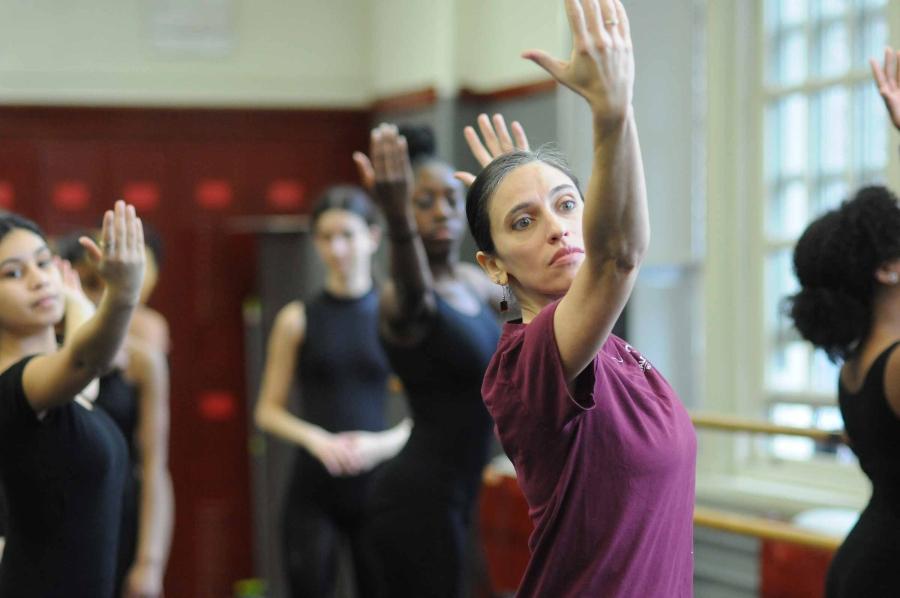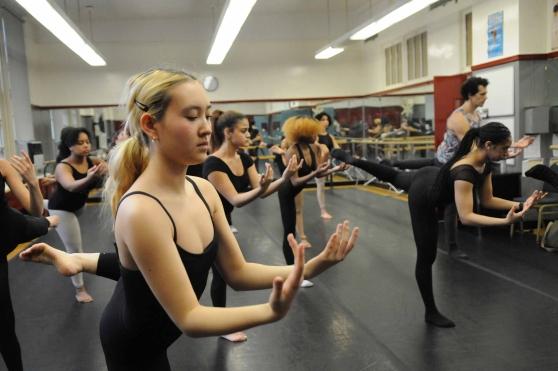Pirouetting into the future

After working as a dancer for a decade, Jessica Danser returned to her alma mater, Talent Unlimited HS, to teach all the workplace skills necessary for a career in the field of dance.

Students in the career and technical education dance program at the school learn not only technique and performance, but also how to choreograph, produce and direct.
A 12th-grader at Talent Unlimited HS who has studied dance her whole life never pictured herself in a dance career because she wanted to “try something new.” Then, as part of the school’s dance program, she completed a social media marketing internship at Young Dancemakers Company, and it changed her mind.
“I learned how to communicate with people and market myself,” among other new skills, she said. Now, she feels prepared for college and for “leadership roles within dance company settings” and is thinking about a future in the dance world she loves.
The internship was part of the Manhattan school’s dance program, which follows the career and technical education model. CTE programs prepare students for their careers by bringing industry partners into the school, placing students in paid internships and covering the practicalities of all the career pathways in a given field. Dance students at Talent Unlimited learn not only technique and performance, but also “how to choreograph, produce and direct,” said Jayne Skoog, the UFT chapter leader.
But Jessica Danser, the teacher who spearheads the program, is quick to explain that her goal is not to steer students away from performance. “Dance and being in a dance company is a workplace skill,” she said, and by taking a career-centric approach, she helps students learn not only technique but how to function “like members of a real dance company.” That includes developing skills like “innovation, collaboration, creativity, teamwork, organization and following directions,” she said.
As an alumna of the school, Danser knows the power of public education for budding performers. She started dancing “like a lot of little girls whose mothers put them in ballet class,” she said, but “it was the public school arts program” that got her hooked and made her realize she wanted a career in dance. Now, many of her students follow in her footsteps.
For Danser, a primary aim is to improve access. One of her 12th-grade students almost had to drop out of studio ballet and modern dance classes this school year because the financial burden on her family was too great. The CTE model allowed Danser to arrange an internship with the studio, and the student was able to finish her programs.
“There are so many kids with inborn, innate talent, and dance studios are extremely expensive,” said Danser. But her program, with its industry partnerships, makes sure that “what the students get in a public school is the same caliber they’d get in a conservatory,” she said.
Danser has conservatory and professional dance experience. After graduating from Talent Unlimited in 2001, she attended the Alvin Ailey School and then worked as a dancer for 10 years. Recruited by her former teacher at Talent Unlimited, she returned there to teach in 2016 after obtaining her CTE license.
Thanks to her industry experience, Danser has given students opportunities to dance with industry professionals from companies including Paul Taylor, Mark Morris and Rod Rogers. Students also learn, through internships and school projects, “every aspect of production: project proposals, choreography, costumes, lighting and performance,” said Danser.
Another 12th-grader said her internship at the Paul Taylor Company made her feel like a professional who was “seeing how things work in the real world.”
Alongside teaching professional skills, the program’s core values include diversity of styles and culturally responsive education. Eighty-five percent of the school’s dance students are people of color, said Danser, and these students “want people who look like them who they connect to culturally” as instructors. When Danser started teaching full-time at Talent Unlimited seven years ago, the classes were “predominantly classical ballet and certain classical dance forms,” she said, but the school now offers African dance, Afro-Caribbean dance, traditional Korean and K-pop styles as well as tap, jazz, ballet and contemporary.
Skoog, the chapter leader, said the diversity in both the student population and the styles of dance offered has contributed to a spike in the school’s popularity. Last year, more prospective students than ever ranked Talent Unlimited as one of their top two high school choices. “We take pride in that,” Skoog said.
As part of the sophomore curriculum, dance students at Talent Unlimited complete a small-group collaboration by choreographing, producing and performing an original work. This process was interrupted by the pandemic, and both students and teachers struggled to connect over Zoom. When Danser returned to the school building in fall 2020, she saw the rack of costumes from abandoned projects and started to cry. But then, in the spring of 2022, when the next group of students presented their projects in person, she said it was “the best choreography she’d ever seen.”
Dance is “finding something you’re passionate about that other kids you see every day are also passionate about,” said Danser. “It’s community.”